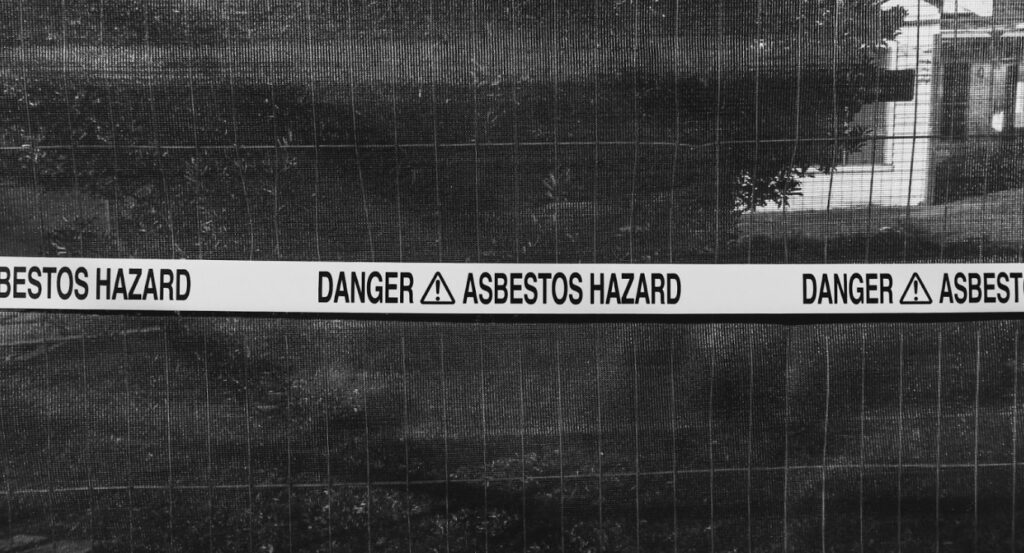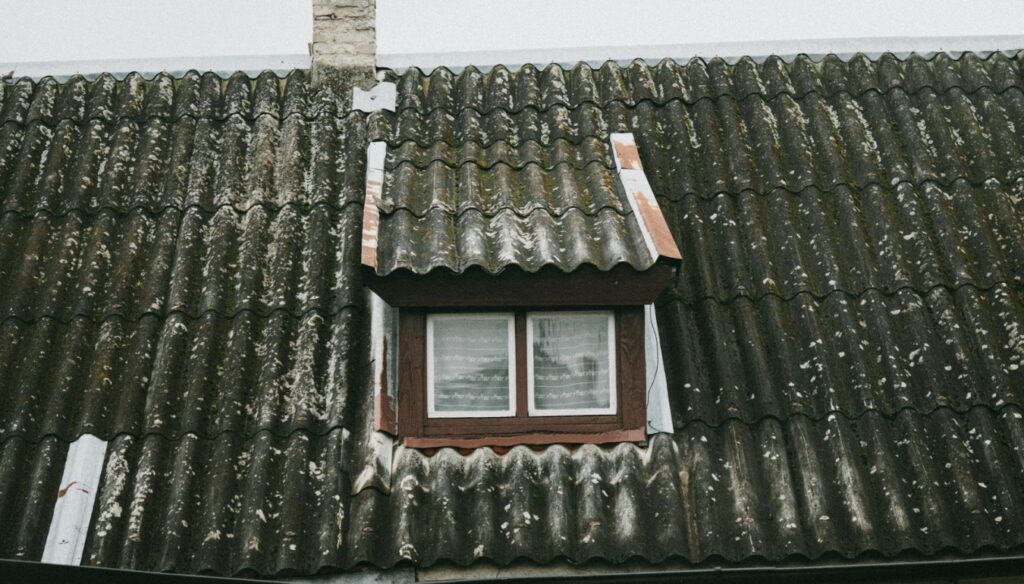Asbestos is a group of naturally occurring silicate minerals with strong, heat-resistant, fibrous crystals. These fibres are durable, chemically inert, and non-combustible, making asbestos widely valued in 20th-century construction.
Asbestos was commonly added to insulation, cement, and fireproofing materials due to its tensile strength and thermal properties. However, the hidden health hazards only emerged decades later.
Many UK buildings still contain legacy asbestos materials, making public understanding essential. This guide explains the types, risks, legal status, and safe management of asbestos across all sectors.

Types and Classification of Asbestos
Asbestos is classified into two mineral groups: serpentine and amphibole. Chrysotile (white asbestos) is the only type of serpentine with curly fibres, which was the most widely used. Amphibole types—amosite, crocidolite, tremolite, actinolite, and anthophyllite—have sharp, needle-like fibres and higher toxicity.
Asbestos-containing materials (ACMs) are also categorised by friability. Friable ACMs release asbestos fibres easily when disturbed, posing higher inhalation risks, while non-friable ACMs are more stable but still hazardous if damaged.
The following table summarises key features:
| Group | Type | Use Example | Friability Risk |
|---|---|---|---|
| Serpentine | Chrysotile | Roofing, floor tiles | Moderate |
| Amphibole | Amosite | Pipe insulation | High |
| Crocidolite | Spray coatings | Very High | |
| Anthophyllite, Tremolite, Actinolite | Contaminant presence | Variable |
Historical Use of Asbestos in the UK & Regulatory Timeline
Asbestos use in the UK peaked from the 1950s to the 1980s in construction, insulation, and manufacturing. It was found in Artex, lagging, floor tiles, roofing sheets, and gaskets. The 1985 ban covered crocidolite and amosite, while the 1999 ban outlawed chrysotile, ending all legal asbestos use.
The Control of Asbestos Regulations 2012 unified previous laws, mandating active asbestos management. Public health awareness of asbestos-related diseases increased through Health and Safety Executive (HSE) updates, underscoring the material’s long-term dangers.
Common Applications of Asbestos
Asbestos was incorporated into a wide range of building materials and fixtures, depending on property type and function, including:
- Domestic properties – Found in insulation boards, textured ceiling coatings, vinyl floor tiles, garage roofs, and boiler flues.
- Commercial sites – Used in pipe lagging, sprayed fire insulation, ceiling panels, and electrical fuse boxes.
- Industrial installations – Present in gaskets, cement sheeting, duct coverings, and plant room linings.
- High-risk locations – Typically located in boiler rooms, roof voids, service risers, and ceiling voids—areas where building disturbance or material degradation may release airborne fibres.

Asbestos Health Risks & Pathology
Asbestos fibres enter the lungs when airborne and inhaled and remain biopersistent—resisting breakdown and accumulating damage over time.
Major asbestos-related diseases include:
- Asbestosis – Chronic lung scarring caused by prolonged inhalation of asbestos fibres, leading to breathing difficulties and reduced lung function.
- Mesothelioma – A rare and aggressive cancer affecting the lining of the lungs (pleura) or abdomen (peritoneum), strongly linked to asbestos exposure.
- Lung cancer – Malignant tumour growth within lung tissue, with asbestos exposure significantly increasing risk, especially in smokers.
- Pleural plaques – Areas of fibrous thickening on the lung lining, indicating asbestos exposure; typically non-cancerous but may be a marker for increased disease risk.
These conditions often manifest decades after exposure. Latency periods range from 10 to 50 years. Current research shows even low-level or incidental exposure may contribute to long-term health risks, especially in vulnerable individuals.
UK Legal Framework & Compliance Regarding Asbestos
The Control of Asbestos Regulations 2012 governs asbestos use and management in the UK. Dutyholders must identify, assess, and manage asbestos risks in non-domestic premises. The “duty to manage” applies to landlords, managing agents, and employers, requiring asbestos surveys, registers, and regular reviews.
Certain works require prior notification to the HSE. Licensable activities must be undertaken by certified professionals. Failure to comply with asbestos-related regulations may result in prohibition notices, fines, or prosecution under health and safety law.
Identification & Testing Methods for Asbestos
Asbestos identification begins with a visual survey by a competent person, identifying suspect materials and logging them in an asbestos register.
Suspected ACMs are sampled using clean tools and sealed containers, maintaining a documented chain of custody. All asbestos samples are analysed at UKAS-accredited laboratories using microscopy.
On-site rapid asbestos test kits are available but have limitations in sensitivity and legal admissibility. For compliance and safety, laboratory analysis remains the standard for conclusive asbestos identification.
Asbestos Surveys: Management vs Refurbishment & Demolition
Asbestos management surveys identify ACMs that may be disturbed during routine occupancy and maintenance.
Refurbishment & Demolition (R&D) asbestos Surveys are required before structural work and are more intrusive. Both require clear site access, trained asbestos surveyors, and secure documentation. Records of asbestos findings must be kept up-to-date and made accessible to workers.
Re-inspections should occur annually or whenever the building is altered. Digital asbestos registers enable live updates and efficient tracking across multiple sites or premises.
Asbestos Risk Assessment & Management Planning
Risk assessments of asbestos classify ACMs based on their condition, location, use frequency, and friability. Damaged, friable, or high-access areas characterise high-priority asbestos materials.
An Asbestos Management Plan (AMP) outlines who is responsible, how ACMs will be monitored, and actions to control exposure. It includes emergency procedures and reinspection schedules. We use software tools like cloud-based registers and mobile apps to manage asbestos in real time, ensuring compliance and worker safety across all site activities.
Remediation & Professional Asbestos Removal
Remediation options for managing asbestos properly include encapsulation (coating), enclosure (isolation), and full removal. Asbestos encapsulation is cost-effective but only suitable for undamaged ACMs. Enclosure of the area containing asbestos reduces access risk, while full removal of asbestos eliminates hazards entirely but is the most expensive.
Licensed contractors for asbestos management erect enclosures, use negative pressure units, and conduct air monitoring. Clearance certification of asbestos is issued after air tests confirm safe reoccupation levels. All processes follow HSE licensing conditions.
DIY Handling & Low-Risk Maintenance of Asbestos
Non-licensed tasks include painting undamaged asbestos cement or sealing minor cracks, provided exposure risk is minimal.
Prohibited activities for asbestos handling include using power tools, sanding, or removing lagging and sprayed coatings. We follow strict safety steps to manage asbestos, which include dampening materials, using Type 5/6 disposable suits and FFP3 masks, and preventing dust release.
Asbestos waste must be double-bagged and clearly labelled. Even for minor jobs, precautions must match HSE guidance to avoid legal and health consequences.
Asbestos Disposal & Waste Management
Asbestos waste is classed as hazardous and must be transported under consignment notes. Only registered waste carriers may handle asbestos waste, which must be double-wrapped and labelled with hazard warnings.
Disposal must occur at licensed landfill sites approved for asbestos. Vehicles must follow ADR transport rules, and waste documents must be retained for asbestos audits. To reduce environmental release due to asbestos, we ensure materials are wetted, bags are sealed tightly, and waste areas are cleaned after each load.
